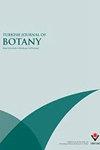Mapping quantitative trait loci and developing first molecular marker for race 5 of Podosphera xanthii resistance in melon (Cucumis melo L.)
IF 1.5
4区 生物学
Q3 PLANT SCIENCES
引用次数: 1
Abstract
: Powdery mildew of melon caused by the Podosphaera xanthii factor is a disease that causes serious yield losses economically in all areas where melon is grown from Asia to Europe and America. The use of resistant varieties for the control of the disease is the most environmentally friendly method. However, traditional methods of melon breeding have made a noteworthy input to resistance varieties improvement, but they have been slow and incompetent in targeting complex powdery mildew disease resistance traits. To overcome these problems and to facilitate breeding programs, molecular markers closely linked to the Pm-R5 gene are needed for marker-assisted selection (MAS). The present study aimed to map quantitative trait locus for powdery mildew resistance and identify the molecular markers linked with the Pm-R gene which provides resistance to race 5 of P. xanthii for MAS breeding in melons. A total of 310 primers/combinations belonging to six marker systems including SRAP, SSR, ISSR, TRAP, CAPS, SCAR in the RIL population consisting of 136 genotypes, developed from crosses PMR-6 and susceptible inbred line were used for QTL mapping. Quantitative trait loci analysis determined one major QTL ( Pm-R ) on linkage group I for resistance to races 5 of powdery mildew. The SSR12202 marker is linked to the Pm-R gene QTL at 2.12 cM genetic distance, and the CMCT170b and CMMS30-3 markers are determined in the support interval of this QTL. The co-dominant markers, together with the map information reported here could be used for genotyping selection of resistance to race 5 of P. xanthii in melon breeding.甜瓜(Cucumis melo L.)黄腐病抗性小种5的数量性状基因座定位及首个分子标记的建立
当前位置由黄氏Podosphaera xanthii因子引起的甜瓜白粉病是一种在从亚洲到欧洲和美洲的所有甜瓜种植地区造成严重经济损失的疾病。利用抗病品种控制病害是最环保的方法。然而,传统的甜瓜育种方法在抗性品种改良方面做出了显著贡献,但在针对复杂的白粉病抗性性状方面进展缓慢,能力不足。为了克服这些问题并促进育种计划,需要与Pm-R5基因密切相关的分子标记来进行标记辅助选择(MAS)。本研究旨在定位瓜类抗白粉病的数量性状位点,并鉴定抗黄氏白粉病5小种的Pm-R基因连锁分子标记,为瓜类抗白粉病育种提供依据。在136个基因型的RIL群体中,利用PMR-6与易感自交系杂交得到的SRAP、SSR、ISSR、TRAP、CAPS、SCAR 6个标记体系共310个引物/组合进行QTL定位。数量性状位点分析确定了抗性白粉病5小种的1个主要QTL (Pm-R)。SSR12202标记与Pm-R基因QTL的遗传距离为2.12 cM, CMCT170b和CMMS30-3标记在该QTL的支持区间内确定。这些共显性标记和本文报道的图谱信息可用于瓜类育种中抗黄氏疫病5小种的基因分型选择。
本文章由计算机程序翻译,如有差异,请以英文原文为准。
求助全文
约1分钟内获得全文
求助全文
来源期刊

Turkish Journal of Botany
PLANT SCIENCES-
CiteScore
2.90
自引率
5.60%
发文量
31
审稿时长
6-12 weeks
期刊介绍:
The Turkish Journal of Botany is published electronically 6 times a year by the Scientific and Technological Research Council of Turkey (TÜBİTAK) and accepts manuscripts (in English) covering all areas of plant biology (including genetics, evolution, systematics, structure, function, development, diversity, conservation biology, biogeography, paleobotany, ontogeny, functional morphology, ecology, reproductive biology, and pollination biology), all levels of organisation (molecular to ecosystem), and all plant groups and allied organisms (algae, fungi, and lichens). Authors are required to frame their research questions and discuss their results in terms of major questions in plant biology. In general, papers that are too narrowly focused, purely descriptive, or broad surveys, or that contain only preliminary data or natural history, will not be considered (*).
The following types of article will be considered:
1. Research articles: Original research in various fields of botany will be evaluated as research articles.
2. Research notes: These include articles such as preliminary notes on a study or manuscripts on the morphological, anatomical, cytological, physiological, biochemical, and other properties of plant, algae, lichen and fungi species.
3. Reviews: Reviews of recent developments, improvements, discoveries, and ideas in various fields of botany.
4. Letters to the editor: These include opinions, comments relating to the publishing policy of the Turkish Journal of Botany, news, and suggestions. Letters should not exceed one journal page.
(*) 1. Raw floristic lists (of algae, lichens, fungi, or plants), species descriptions, chorological studies, and plant sociology studies without any additional independent approaches.
2. Comparative morphology and anatomy studies (that do not cover a family, tribe, subtribe, genus, subgenus, section, subsection, or species complexes with taxonomical problems) without one or more independent additional approaches such as phylogenetical, micromorphological, chromosomal and anatomical analyses.
3. Revisions of family, tribe, genus, subgenus, section, subsection, or species complexes without any original outputs such as taxonomical status changes, IUCN categories, and phenological and ecological analyses.
4. New taxa of all plants without any additional independent approaches such as phylogenetical, ecological, chromosomal, chorological and correlational analyses in addition to a detailed macro- and micro-morphological descriptions with quality field and microscopic illustrations of taxonomically important structures and identification key in the taxonomic group.
New records of all plants without any additional independent approaches such as phylogenetical, ecological, chromosomal, chorological and correlational analyses in addition to a detailed macro- and micro-morphological descriptions with quality field and microscopic illustrations of taxonomically important structures and identification key in the taxonomic group may be accepted for peer review if they contain 3 or more new records or taxonomical status update, such as lectotypification, new combinations, transfers, revivals and synonyms.
5. New taxa of algae, lichens, and fungi without any additional independent approaches such as phylogenetical, ecological, chromosomal, chorological and correlational analyses in addition to a detailed macro- and micro-morphological descriptions with quality field and microscopic illustrations of taxonomically important structures and identification key in the taxonomic group.
New records of algae, lichens, and fungi without any additional independent approaches such as phylogenetical, ecological, chromosomal, chorological and correlational analyses in addition to a detailed macro- and micro-morphological descriptions with quality field and microscopic illustrations of taxonomically important structures and identification key in the taxonomic group may be accepted for peer review if they contain 5 or more new records or taxonomical status update, such as lectotypification, new combinations, transfers, revivals and synonyms.
 求助内容:
求助内容: 应助结果提醒方式:
应助结果提醒方式:


